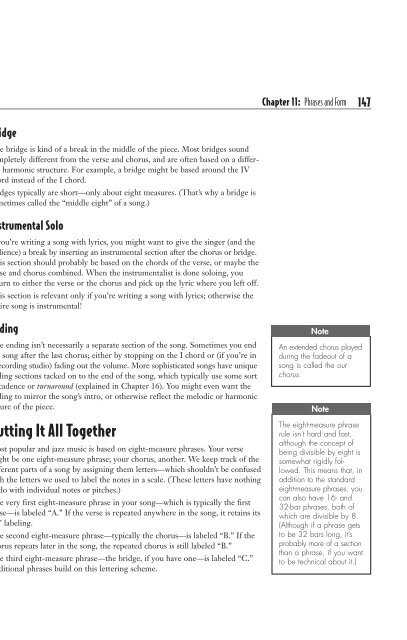The_Complete_Idiot%27s_Guide_To_Music_Theory
The_Complete_Idiot%27s_Guide_To_Music_Theory
The_Complete_Idiot%27s_Guide_To_Music_Theory
You also want an ePaper? Increase the reach of your titles
YUMPU automatically turns print PDFs into web optimized ePapers that Google loves.
Bridge<br />
<strong>The</strong> bridge is kind of a break in the middle of the piece. Most bridges sound<br />
completely different from the verse and chorus, and are often based on a different<br />
harmonic structure. For example, a bridge might be based around the IV<br />
chord instead of the I chord.<br />
Bridges typically are short—only about eight measures. (That’s why a bridge is<br />
sometimes called the “middle eight” of a song.)<br />
Instrumental Solo<br />
If you’re writing a song with lyrics, you might want to give the singer (and the<br />
audience) a break by inserting an instrumental section after the chorus or bridge.<br />
This section should probably be based on the chords of the verse, or maybe the<br />
verse and chorus combined. When the instrumentalist is done soloing, you<br />
return to either the verse or the chorus and pick up the lyric where you left off.<br />
This section is relevant only if you’re writing a song with lyrics; otherwise the<br />
entire song is instrumental!<br />
Ending<br />
<strong>The</strong> ending isn’t necessarily a separate section of the song. Sometimes you end<br />
the song after the last chorus; either by stopping on the I chord or (if you’re in<br />
a recording studio) fading out the volume. More sophisticated songs have unique<br />
ending sections tacked on to the end of the song, which typically use some sort<br />
of cadence or turnaround (explained in Chapter 16). You might even want the<br />
ending to mirror the song’s intro, or otherwise reflect the melodic or harmonic<br />
nature of the piece.<br />
Putting It All <strong>To</strong>gether<br />
Most popular and jazz music is based on eight-measure phrases. Your verse<br />
might be one eight-measure phrase; your chorus, another. We keep track of the<br />
different parts of a song by assigning them letters—which shouldn’t be confused<br />
with the letters we used to label the notes in a scale. (<strong>The</strong>se letters have nothing<br />
to do with individual notes or pitches.)<br />
<strong>The</strong> very first eight-measure phrase in your song—which is typically the first<br />
verse—is labeled “A.” If the verse is repeated anywhere in the song, it retains its<br />
“A” labeling.<br />
<strong>The</strong> second eight-measure phrase—typically the chorus—is labeled “B.” If the<br />
chorus repeats later in the song, the repeated chorus is still labeled “B.”<br />
<strong>The</strong> third eight-measure phrase—the bridge, if you have one—is labeled “C.”<br />
Additional phrases build on this lettering scheme.<br />
Chapter 11: Phrases and Form 147<br />
Note<br />
An extended chorus played<br />
during the fadeout of a<br />
song is called the out<br />
chorus.<br />
Note<br />
<strong>The</strong> eight-measure phrase<br />
rule isn’t hard and fast,<br />
although the concept of<br />
being divisible by eight is<br />
somewhat rigidly followed.<br />
This means that, in<br />
addition to the standard<br />
eight-measure phrases, you<br />
can also have 16- and<br />
32-bar phrases, both of<br />
which are divisible by 8.<br />
(Although if a phrase gets<br />
to be 32 bars long, it’s<br />
probably more of a section<br />
than a phrase, if you want<br />
to be technical about it.)


